Enjoy
Blog
Contents
An Interview with Angela Kilford
September 11 2015
Angela Kilford is a Wellington based performance artist whose practice is centred on the act of walking and conversation as way of examining the physical, cultural and social histories of a given site.
Angela has recently exhibited the Reclamation Walk during the 2014 Performance Arcade and was part of the Enjoy Offsite exhibition The levelling of Puke Ahu in March 2015. Elisabeth Pointon has participated in a number of her works and sat down with Angela to discuss her most recent performance with Aliyah Winter–Walk on Fallow Lands at Toi Poneke.
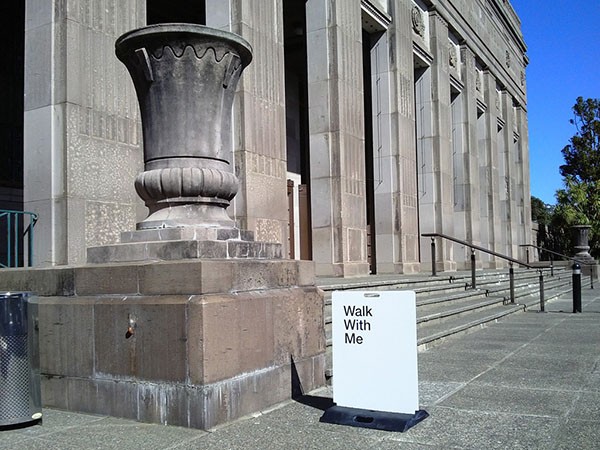
–
Elisabeth Pointon: Would you please start with giving us a broad insight into your art practice and the philosophies that inform it?
Angela Kilford: As a whole? That's huge isn't it?
I think it sort of makes sense if you know a little bit about what I am aiming for in my art practice and where I am coming from. I would describe my art practice as participatory, public art, with the live art event as the priority in my practice. So, I walk with people! The way my art practice has been formed has come about through investigating memories and landscape. Looking at memory and how it is in place in the land, and walking with people and guiding people actually started as a way of raising the value of oral histories. So my very first inaugural performance ever (art performance) was a kind of guided walk around the National War Memorial where I only told stories of what I had heard or learnt from other people and tried to sort of ignore any heavy material research and just focused on folk stories that I had been told. I think what that does is challenge officially recorded histories, and hopefully raise the value of stories people have told me and try to disrupt the narrative of a place that is already there by offering an alternative. Sort of allowing people to re-imagine the place. That's what it has become and I think that future works will continue re-imagining and reconnecting with places, noticing patterns and signs, finding changes in the city and understanding how these things change our sense of place, so I can see that these things are now core to my practice.
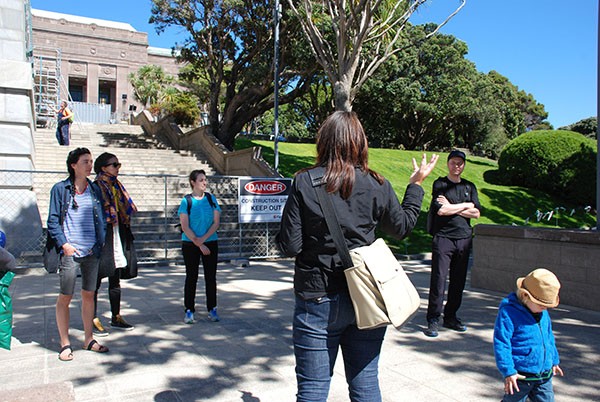
E: So, as a site-specific work, how do you decide on a site in the first instance?
A: Actually, for the very first project if we are talking methodology, I chose and was drawn to that site because of the heavy narratives that were already in the place. It was the National War Memorial and I was looking at a collective memory, and how can you say that a memory is the same for all people? I read a lot about theories of memory, so I chose the National War Memorial because there was such a huge change going on in that landscape, and I stuck with it. I was then involved in an accident at that site and that really cemented the relationship between me and that place. It gave me the impetus, I guess, to keep going with it, but the more recent projects that I had done, I feel like the sites have been chosen for me, as it had to be in relation to an event for something. For the Performance Arcade it only made sense for me to explore the old shore line on which it was situated, and just looking at the environment itself in context of Toi.
E: With the Toi Poineke work, the route around a lot of the area was under a lot of construction, and the landscape changed daily, how did you accommodate that within your walk?
A: It is something that I am worried about when I am researching the place for the work. But I shouldn't be, because of the new seal on the road and new paving, we know that its new and the place has changed, there is evidence of this huge upheaval. It's only then tricky for people with mobility issues, for practical reasons. The fact that is changing every day is okay, because it adds to it.
E: So it is almost a collaboration with the site?
A: Yeah it is, and actually I think it is what mythogeographers talk about (mythogeography that's after psychogeography). They talk about the streets, like trees being non-human objects in a dialogue, and how these streets become a part of the dialogue as well, a non-human object. They are real and they are there, and contributing in some way, it's crazy!
E: How did having the physical space of Toi Poineke’s main gallery contribute the work , and how did that change this work from the other iterations of this work, especially in regards to documentation?
A: It's quite cool because it gives you a perimeter. Otherwise you can research for a long time and everything but it meant that it was always going to be the starting point, the meeting point for the walk, and it gave me some practical considerations. For example, if you are looking at doing something that’s one to two hours, where can you explore from there? I am drawn to areas of change and regeneration and the walk comes out of that. You are walking the area and researching it at the same time, which informs those decisions on which routes to take.
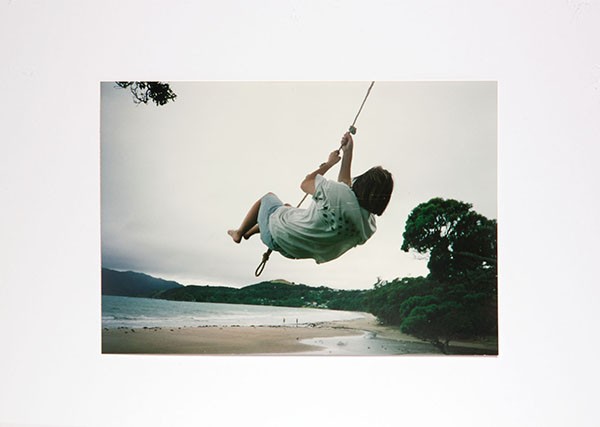
Contribution from Janet Blake for Walk on Fallow Lands.
A: It gave me the opportunity to explore other areas of my practice. Something that is probably under explored, and I think it was a really good challenge to think about how documentation could compliment the performance. I think what Aliyah and I were aiming for was that neither element of the work competed with the other. I have been reluctant, so far, to make a film walk or an audio walk, not just because it has been done before, but because of the purpose of my practice, it didn't seem logical - it is in the live event. Then there is the idea that you explore multiple stories around an idea, which could be also be an object. I see Pohutakawa as an idea, rather than a thing, and there are multiple meanings around a place as well and we were hoping people see these parrallels in the work.
E: So where does the significance of the Pohutakawa come from? Was it one of the first things you were interested in exploring.
A: Well it's probably because I was asked to research them, the stories that were already circling this Pohutakawa tree. I actually once received an email from the Memorial Park Alliance, or the NZTA on behalf of the MPA (Memorial Park Alliance) and the subject line was something like “100 Pohutakawa, the significance of the Pohutakawa tree” and this idea around one hundred, it’s like if you ask a small child “how many kids were there at the party?” and they would respond with something like “a hundred!”. I love that it is not mathematically correct but we think “wow, that's so impressive!”, there is a hundred of something, and you counted them. Being asked to officially record the cultural significance of something that is already special to people was really interesting, that's why I chose it. I did hours of research for the MPA and at the end of the day, it was sort of going, well, we already knew that they were special and can we make something of that as well.
E: Just going back to the documentation of your work, in this walk you had an iPad strapped to your back, filming your progress. How will that information be used and how did that change the dynamic of your walking experience?
A: It was interesting because I just got used to wearing it, and to be honest, I hadn't really thought of it ethically, it is not something that Toi Poineke were ever worried about really! Perhaps that is something I really need to look at ethically and culturally, incidentally capturing people. Really, the impetus for doing that was a whakatauki “I nga wa o mua”.
The whakatauki basically means we can't see into our future, but we can look at our past because we know what happened in the past, we know what happened a few moments ago, but we don't know what's going to happen in a few minutes. So when I started recording where I had been, it was live-streamed in front of me, so that I was walking towards it, so I was walking towards my past. It was exploring that idea of projecting the past for you, and a kind of statement around the idea that when we are looking at areas of the city that are being heavily disturbed and changed, you question “can we look to the past and look behind us before we start moving forward”. It reminds me of another thing, a quote by Walter Benjamin about the Angelus Novus, the Angel of History? It's talking about a Paul Klee painting and how the Angel of Progress looks back and everything is piling up. This idea that it came from both a Maori Whakatauki and a European Art History, that's what propelled me to do it in the first place.
E: Who is your perfect participant? Is there such a person?
A: I don't have a perfect participant, but I did meet some pretty cool participants lately! In terms of audience, I was asked to specify by my supervisors, when I was doing my Master's project, who is your audience? Is it the art community or Joe Public? I thought, “well, actually, I am going to aim for both”. I am still trying that, and still trying to get to two levels of public, because, I think, if people leave a performance and they get one thing from it, then that's significant in itself. I think there is a lot put on artists, to make these profound impacts and effects on people, and we don't always get it right, especially when you are doing live work with different people all the time.
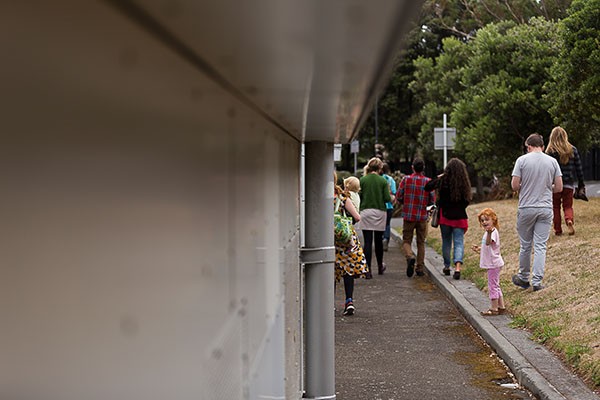
E: I think what was obvious to me, from my experience of Walk on Fallow Lands, was that a little community was inevitably created amongst the people who all showed up at that particular time. You do get people, from all walks of life, it wasn't just the same art community.
A: I was challenged in our MFA with a provocation to create a practice that was useful in today's world. And I just took it on. I follow Future Farmers, Amy Franceschini, and the Flat Bread Society. Amy recently did a work where she did gardening demonstrations in the middle of San Francisco! And this event has effectively changed the way Local Government have made their policies, and I think that shows really working with the community in a really profound way.
E: Another thing I found really beautiful about the work was how it functioned as a collaborative action, in terms of the participants. It wasn't just you standing there and giving us information, it was everyone contributing to a build up of history or collective ideas about the place we were moving through. Was that something you expected or anticipated - That people would be so receptive and open with their contributions?
A: It's something I hoped for a long time and I know when I wrote my first proposal to Toi Poineke, I said that other people would add their own personal stories that would then become a part of the work. And that was just a really big hope! It really relied on a range of public coming to participate in the work, and I hope that they feel they have collectively contributed to something. There are some things that you hope for as an artist, that you don't ever want to assume you would be able to achieve, like the idea that would add value to somebody's life, that would be awesome. You want to enable that.
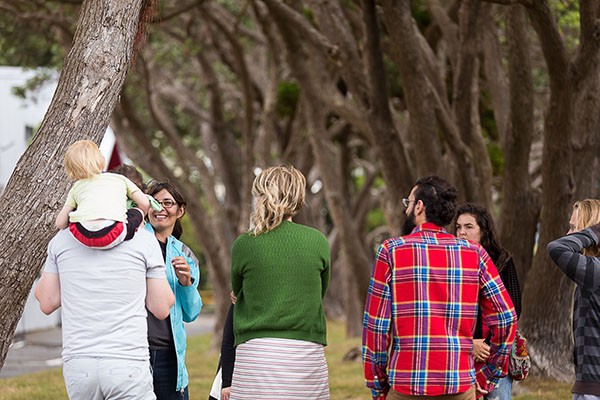
E: In my experience of Walk on Fallow Lands, I felt like I got an exceptionally great deal - we had a young lady in our group who used to live on Tonks Grove, and the personal, first hand history we heard was really fascinating. Because we had so many participants, and were all bouncing off one another, you were this lovely reference point, making sure that we would return to the site, and not get completely off topic. It was done in such a subtle way, that did not detract from or cut across the experience of forming our own community.
A: - I have learnt that some things are out of your control, and nobody expects you to really reign people in. There’s an opportunity to meet others in your city and come together in shared experience. There were stretches on this walk when I purposefully just let people walk for a bit, and take it easy, seeing how these relationships can form. Again it is about enabling and hoping!
E: It didn't feel like we were an audience at a performance, the work was so warm and the invitation for participation meant that we didn’t feel like “this is art!”.
A: That's so interesting, because some people in the art community who would see that as problematic, 'am I just being a tour-guide', like any other tour guide. It is really difficult because I think that the way I walk is different, it is so subjective. I don't think other tour guides realise that they are being subjective at all, that it is their story...they are telling 'the story', and I am telling you 'it's my story'.
E: I guess on that note, did you have any difficult participants?
A: A couple, but one in particular, who booked really early on. I don't know whether it was because they saw that there was something free in the city…I am not really sure what they expected. Every time I mentioned something Maori, she rolled her eyes, and that's was a bit disturbing. Other people asked whether or not the mihimihi was necessary, but for me I am asserting Te Reo over the land. We talk about Abel Smith Street, and nobody knows who Abel Smith was, it is the Colonial story that has been inscribed on the streets. This is my work, I will speak Te Reo if I want, I will talk about Maori. I don't know then, what the work means to that person, but I can't be too worried about that because if a person has already made their mind up, then that's that.
E: I have found that the most touching thing for me about these works, and I saw it in the Puke Ahu work as well, is the Karakia and waiata at the end, because everybody joins in. You had a similar finish on the Walk on Fallow Lands. It completely cemented our community that we had formed over the past 2 hours, because it was different, and intimate, and I am not sure that it would have had the same effect, had the conclusion been in English. There was a lady, who happened to be passing by on the street during my group's wrap-up, and you both spoke Te Reo to one another. It was a lovely affirmation of how the work has so much reach.

A: Interesting isn't it? Some people can see that as sentimentalism, but there is more to it than that. I think all artists put themselves in a vulnerable position, and that's what creates openness with people. I will push myself even if it is uncomfortable, to do these things, to sing in front of somebody, because my vulnerability will hopefully provide a space for some sort of interaction to occur, or to experience the art in another way. I think that is what most artists are doing and hoping for. When you think about the difficult participant I had, I don't really know why, maybe they thought “can we just get over being Maori?” It was actually upsetting for some of the other participants, they came and spoke to me about it afterwards. They were more upset than I was I think, because I had to just keep going.
E: Do you have any favourite stories or any new understandings from participants?
A: I think one woman’s story about her mother being born in a house by the motorway was really poignant.
This woman who came on the walk was really encouraged by the mihimihi I gave, and the idea of being a visitor who is from here. We stopped on the new big paved area on Victoria Street, the precinct and I asked her where she was from. It turned out that she was a local Wellingtonian and that her mother was born in a house that was destroyed to build the big, urban motorway. But the piece of land is still there, on the corner of Ghuznee and Victoria Street, and you can still see it! She described how when her grandparents finally gave up on that house and signed it over to NZ Transit, and her grandfather went down to the law offices to sign the house over for sale. Afterwards, he said that he just wanted to go back and take one last photograph of the house, but by the time went back they had already started wrecking it with a wrecking ball. It was already being demolished, they had handed over the keys and it was no longer theirs. They never got that last picture and her story could have been the whole artwork - how does this dramatic change in the landscape change sense or feeling of place? For her, it was looking at this place, seeing where she was from. It was really profound. She came back to the closing event and made friends with another lady.
E: What artists do you particularly affiliate with, or your practice aligns with, or that you go back to time and time again?
A: Amy Franceschini, Janet Cardiff, Phil Smith, Tim Brennan and Simon Pope
E: What is happening next with your work?
A: I am heading off to Melbourne in early October to be a part of the Performing Mobilities Symposium, which is a part of the Performance Studies International and Fluid States, to organise meetings with the indigenous people of Melbourne and just see if I can make a performance that is a direct response to an indigenous understanding of the land and place from a Maori perspective. I feel like it is quite an ambitious project, because I can't exactly forget everything I know about European Art History and models. I still always consider that in my practice, but it would be good to take the coloniser out of the equation. So I am thinking about a walk, or something similar that is just based on those understandings and natural histories. I think natural histories of a place is a great way to find out about geography (as it changes so dramatically) and excavating that in a profound way.
E: I am excited!
A: I need a research companion! Want to come?
E: Done deal.
FIN.
